tech blog 3: problem solving
A post discussing problems,
solutions and reflections on
problem-solving techniques when writing
javascript.
a simple problem
context
In order to practise specific programming skills in JavaScript we were
given simple exercises called Katas. During the first kata I faced a
simple problem.
As a language JavaScript focuses on something called objects. These
objects are similar to objects in the real world - we could have a tree,
a chair, a human or a car object. JavaScript objects exist in the world
of code and can hold information about specific objects and their
properties. For example, a chair might have the material property of
wood. A person might have a name property of “Olivia.” Properties and
objects exist in key value pairs, which sit inside an object. A person
object, called person with three properties, looks like this:
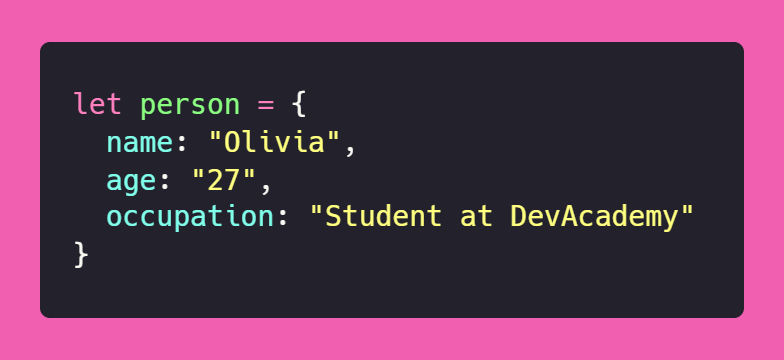
It is simple to change a property within an object, we simply refer to
the object and the property, and assign it a new value, like this:

Or, like this:

Both will result in the name property of the person object being changed
to “O G Clarke-Edwards”.
problem
The problem that arose for me was that I didn’t know how to add a new
property to an existing object which didn’t already have that property.
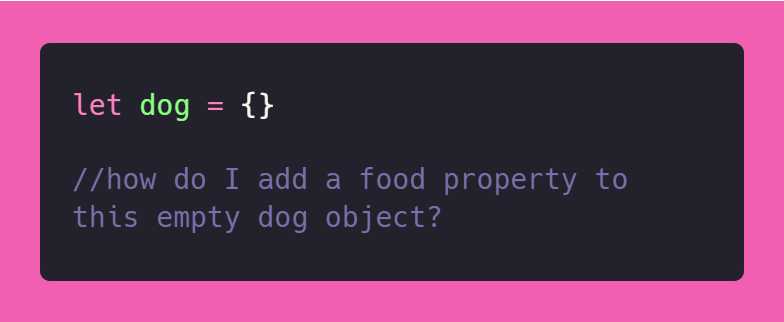
solution
A quick Google search brought up the relevant documentation - I didn’t
even open any pages, just read the sample text below the first link and
was away laughing. The solution is that adding a key-value pair to an
object is done in the same way as changing an existing property. When
the code runs, it looks for the key, and if the specified key doesn’t
exist, it creates a new one. So…
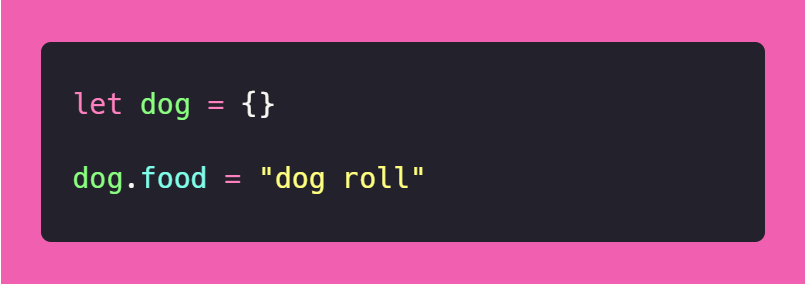
or...
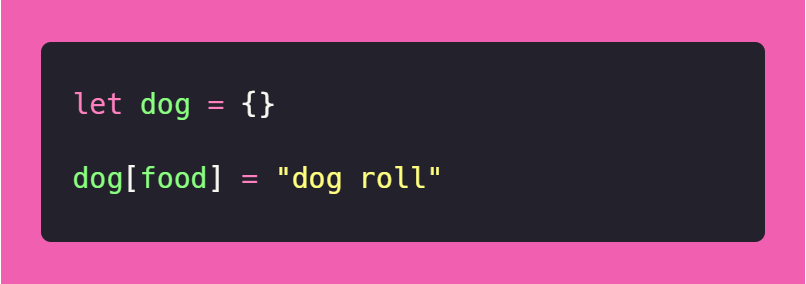
will result in a dog object with the property of food set to “dog roll”.
feelings
I was a little hard on myself with this problem, because for some reason
I felt like I should know how to do this already, but looking up the
answer was a quick reminder of how this should work. I felt relieved
when I saw that the answer was so simple.
learning
I learnt how to add a key-value pair to an existing object that doesn’t
already contain the required property. I also learnt that I expect
myself to know everything, which is a little unreasonable and
unnecessary, considering that everything is but a quick Google away and
I am only just learning to use JavaScript.
an elegantly
solved problem
context
In JavaScript you can create little tools called functions, which do
tasks for you. You can hand them stuff (input) and they can return stuff
(output). You can also get functions to manipulate, create or get rid of
stuff. If you write a function, you can use that function over and over
again! If you write the right functions, your future self can be
grateful to your clever function writing self, because the function does
the clever stuff over and over with NO EXTRA BRAIN POWER required!
In one kata, we had to add student objects to a gradebook, and give them
a property which contains all their test scores. In order to add the
students to the gradebook and add scores, I wrote two functions.

The two functions that I initially created manipulated an existing
gradebook, student array (you can think of an array as a collection of
data) and scores array that had been provided to us for our challenges,
within our program.
The final task was to write a function called enterScores(gradebook,
students, scores) which gets handed an empty gradebook, an array of
students and an array of scores and adds the students as objects into
the array, and these scores as properties.
problem
I wanted to use my existing functions to add the given students and
scores to the newly received gradebook object. But, my initial functions
referred to the gradebook, students and scores provided earlier in my
program, not new ones specified at the time of calling the function.
solution
Instead of throwing my hands and my functions up into the air in
despair, I called upon the higher powers of my brain to provide me with
guidance. Using testing to steer me in the desired direction, I decided
to parameterise the functions I had created earlier. That is, instead of
just letting them grab their own stuff to work with, I would tell them
what they were allowed to work with, and create a pipeline for them to
get the gradebook, scores and students when calling the function.
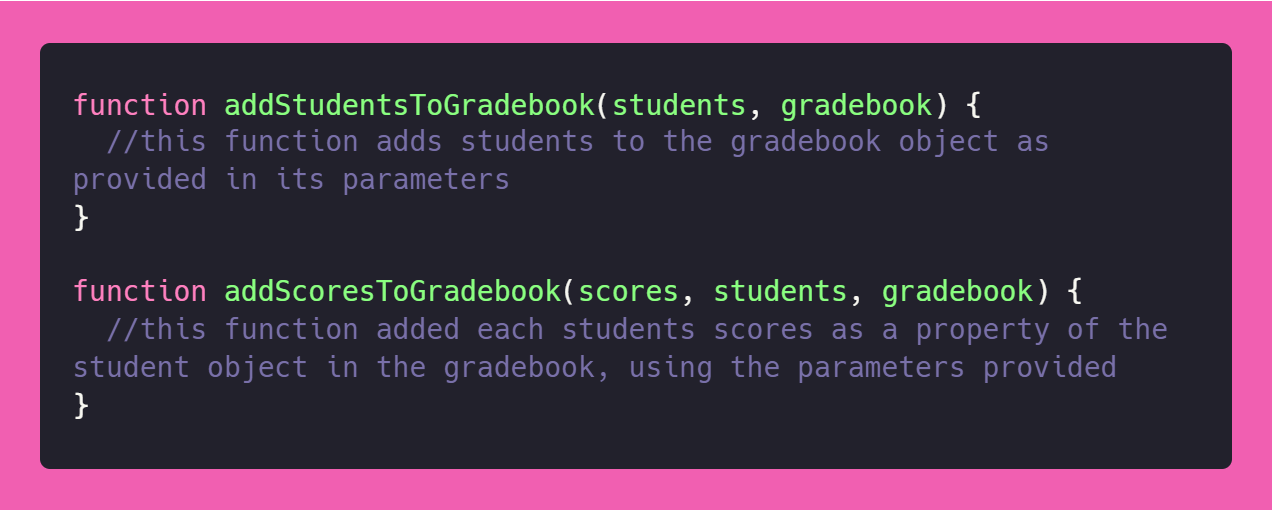
This way I could pass the provided parameters to my existing functions
and utilise my previously written code in an effective and elegant way.
Parameterizing my functions also meant that if I had to use these
functions more frequently in different contexts, they would be generally
applicable, rather than being stuck to specific variables.
feelings
I had fun trying to wrangle my functions into a form that efficiently
and effectively solved my problem. It was frustrating at times, but good
frustrating because it provided my brain with something to wrestle with.
learning
I learnt that generalising functions is super important - this could be
a good thing to have known when I initially wrote my functions so that I
didn’t have to spend time reworking them later. Adding parameters to my
function instead of using external variables made them transferable.
I learnt about myself that I like to find clever and clean ways of
implementing solutions, and that I enjoy the challenge of simplifying my
code and increasing its functionality.
problem-solving
techniques
The following is a reflection on how confidant I feel on using each
problem-solving technique that we have learnt about this week.
pseudocode
I feel quite confidant about using pseudocode in principle... okay - I kinda skipped the pseudocode task that we were meant to do by
accident. Pseudocode is the practice of writing out steps that you want
your code to execute in natural language - in my case, English.
My reflection on pseudocode is that I feel quite confident about using
it if I need to, but that I often just dive in and forget to lay out a
plan for my code beforehand. I think pseudocode would be a great tool
for me to practise using more, in order to slow down and really plan out
my approach to a problem.
My natural reaction to the idea of pseudocode is that it sounds like
making coding boring, but my rational reaction is that pseudocode seems
like a smart idea for writing better code more efficiently!
trying something
Super comfortable just trying something out. Love this problem solving technique - I might utilise it a little too
much. I enjoy a bit of trial and error, but it can become frustrating
without the aid of other problem solving measures.
rubber ducky method
Not super confidant with using this. I like talking to flesh and blood people about my problems though, so maybe this would be helpful for me. Great concept - actually I think I use this one without realising it. My
version is just called the Discord ducky… I post the problem on Discord
and then I figure out the answer before anyone has a chance to respond.
Top notch technique - kinda feel like my technique kills two birds with
one stone because if I DON’T figure out the answer, then I’m also
“asking my peers/coaches for help” at the same time as rubber duckying.
I guess rubber duckying eliminates the part about wasting other people's
time… I think I should try the cute cactus method sometime!
error messages
I feel pretty confident about consulting error messages for problem-solving. Top notch problem solving technique. Error messages are literally the
best. Especially when combined with Googling. Okay, some error messages
suck, but there’s nothing better than a well-formulated, informative
error message to get the show back on the road.
console.logging
Not super duper confidant with this one, but definitely improving swiftly because I have realised that console.log() gives the ultimate insight into what my code is ACTUALLY doing. Praise be to
console.log()!
Googling
Love Google, feel pretty confident about problem solving using Google for the most part. My good friend Google has all the answers. Sometimes incomprehensible
ones, but when it comes to JS documentation, it's pretty straightforward
and helpful. MDN is an insanely useful resource, especially when the
main problem is just syntactical chaos. Love me a good Google search
full of typos because I’m racing to get solutions.
asking peers for help
Not super confident. A little scared of peer judgement, eek. Peers are great in theory though. I've received some great advice from my homegroup already. Haven’t really had a chance to get help
from peers yet but definitely open to this. I have noticed when I have
tried to help people I get so excited and my help is super chaotic, but
I think it's cool for us to work together!
asking coaches for help
Pretty confidant although I feel like I'm almost too active in Discord, so I feel awkward.
Good for weird problems and for when Google gives aforementioned
incomprehensible answers!
improving process with reflection
Not super confident. Can do the reflection part but I don't know if it actively improves my problem solving process. I hate this but I think it's a good one. I think I just find it a little
boring and I find it hard to be systematic because it just seems super
tedious. The research says it works though. I guess this is a reflection
right now, so it's not too bad really!







